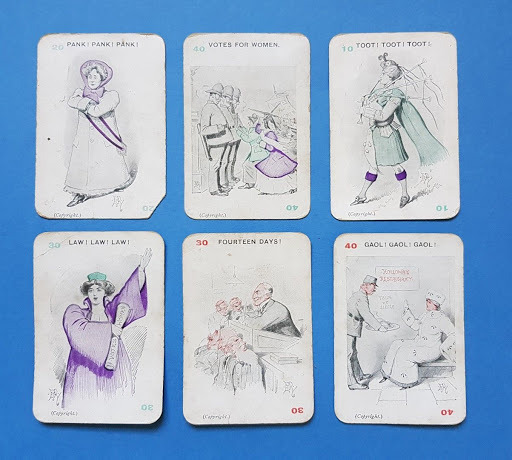The Lost Game Of Panko

The Panko Votes For Women card game completes our look at suffragette-inspired games. Named after the prominent suffragette, Emmeline Pankhurst, it was first advertised in the magazine, Votes for Women, on December 10, 1909 and was part of the Women’s Social and Political Union’s innovative commercial strategy to promote their cause and to raise vital funds.
Selling at two shillings and published by Peter Gurney Ltd, the game consisted of a pack of forty-eight cards, each featuring a caricature of leading figures involved in both sides of the suffragette struggle and scenes of involving suffragettes and the forces of oppression aka the police. Each was drawn by Edward Tennyson Reed, a prominent English political cartoonist well known for his work for the magazine, Punch. They are wonderful pieces of work laced with humour. As the game’s advertisement gushes, “not only is each picture in itself an interesting memento but the game produces intense excitement without the slightest hint of bitterness”.

This claim may seem a little over the top as the game was a card game akin to rummy, pitting supporters and opponents of the suffrage cause against each other. There were eight sets of six cards, grouped by the following slogans, which presumably, were commonly heard during the campaign; “Fourteen Days!, Votes for Women, Toot! Toot! Toot!, Law! Law! Law!, Gaol! Gaol! Gaol!, Help! Help! Help!, Turn ‘Em Out!, and Pank! Pank! Pank!”. Each card had a purple back, one of the colours favoured by the suffragettes.
The object of the game was to collect all of the six cards in a set, the first player to do so being the winner. Simplicity itself, but you can imagine that it was a game that was played more than once. What is more interesting is the psychology behind it, spreading the suffrage message into homes where the master may not have been supportive of the idea but might have turned a blind eye to a seemingly innocent game.

To this end, Reed’s illustrations deserve closer scrutiny. Take one of the Gaol! Gaol! Gaol! Cards. it depicts a suffragette in her prison uniform refusing a tray of food proffered by her gaoler. A sign on the back wall reads “Holloway Restaurant” and below it the slogan “Faim de siècle”, a play on fin de siècle. It is tempting to think that the prisoner is Wallace Dunlop, jailed for printing an extract from the bill of rights in the House of Commons. She was the first to refuse all food, initiating what became one of the suffragettes’ most successful tactics, the hunger strike. At a glance, the card just portrays what seems to have been a common scene, a suffragette refusing food, but there are more subtle messages being portrayed.
More of these games seemed to have survived, perhaps because of its convenient size and the quality of the illustrations on the cards, and shed a fascinating insight on the struggles and tactics deployed in Edwardian England.



